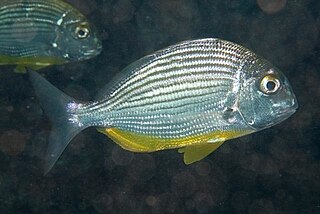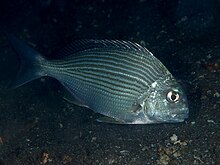
Sparidae is a family of ray-finned fishes belonging to the order Spariformes, the seabreams and porgies, although they were traditionally classified in the order Perciformes. They are found in shallow temperate and tropical waters around the world and are demersal carnivores.

Lithognathus is a genus of marine ray-finned fish belonging to the family Sparidae, which includes the seabreams and porgies. Species in this genus are given the common name of steenbras. The genus is found in the Eastern Atlantic Ocean from southwestern Europe to South Africa and into the southwestern Indian Ocean.

Argyrops spinifer, the king soldierbream, Bowen snapper, long-spined red bream, longfin snapper, longspine seabream and red bokako, It is a species of marine ray-finned fish belonging to the family Sparidae. This species is found in the Indian Ocean.

Diplodus is a genus of marine ray-finned fish belonging the family Sparidae, which includes the seabreams and porgies. These fishes are found in the Atlantic Ocean, the Mediterranean Sea and the western Indian Ocean.

Rhabdosargus holubi, the Cape stumpnose, is a species of fish in the seabream family, Sparidae. It is native to southern Africa, where it can be found mainly along the eastern coast of South Africa.

Rhabdosargus sarba, also known as the goldlined seabream, silver bream, tarwhine, or yellowfin bream, is a species of marine ray-finned fish belonging to the family Sparidae, which includes the seabreams and porgies. This fish has a wide Indo-Pacific distribution.

Sparidentex is a genus of ray-finned fish belonging to the family Sparidae, which includes the seabreams and porgies. These fishes are found in the Indian Ocean.

Acanthopagrus is a genus of marine ray-finned fishes belonging to the family Sparidae, the sea breams and porgies. The fish in this genus are found in the Indian and western Pacific Oceans.

Acanthopagrus berda, the goldsilk seabream, sly bream, picnic seabream, black sea bream, black porgy, picky bream, silver bream or river bream, is a species of ray-finned fish belonging to the family Sparidae, the sea breams and porgies. This species is found in the Indian Ocean.

Dentex is a genus of marine ray-finned fishes belonging to the family Sparidae, which includes the seabreams and porgies. The fishes in this genus are found in the eastern Atlantic Ocean and the eastern Indian and Western Pacific Oceans.

Crenidens is a small genus of three species of seabream from the family Sparidae from the western Indian Ocean. It was previously regarded as monotypic, with the sole species being the Karenteen sea bream Crenidens crenidens but two other species are now accepted as valid species, separate from the type species, C. crenidens.

Sparodon, commonly known as the white musselcracker, musselcracker seabream, mussel cracker seabream, brusher, or cracker. is a monotypic genus of fish in the family Sparidae. The type and only known species, Sparodon durbanensis, was first described and named by François Louis Nompar de Caumont de Laporte, comte de Castelnau, in 1861.

Spondyliosoma is a genus of marine ray-finned fish belonging to the family Sparidae, which includes the seabreams and porgies. The genus contains two species, one, the black seabream, from the eastern Atlantic Ocean and the other, the steentjie seabream, from the western Indian Ocean.

Argyrops is a genus of marine ray-finned fishes belonging to the family Sparidae, the seabreams and porgies. These fishes are found in the coasts of Indian Ocean and near Australia.

Rhabdosargus globiceps, the white stumpnose or go-home fish, is a species of marine ray-finned fish belonging to the family Sparidae, which includes the seabreams and porgies. This fish is endemic to the waters off Southern Africa.

Rhabdosargus thorpei, the bigeye stumpnose, is a species of marine ray-finned fish belonging to the family Sparidae, which includes the seabreams and porgies. The bigeye stumpnose is endemic to the southwestern Indian Ocean.

Rhabdosargus haffara, the haffara seabream or Haffara stumpnose, is a species of marine ray-finned fish belonging to the family Sparidae, which includes the seabreams and porgies. This fish is found in the northwestern Indian Ocean.
Rhabdosargus niger, the blackish stumpnose, is a species of marine ray-finned fish belonging to the family Sparidae, which includes the seabreams and porgies. This fish is known only from the western coast of Kalimantan in Indonesia.

Chrysoblephus is a genus of marine ray-finned fishes belonging to the family Sparidae, the sea breams and porgies. The fish in this genus are found in the western Indian Ocean and southeastern Atlantic Ocean.
Chrysoblephus lophus, the false red stumpnose or the false Englishman, is a species of marine ray-finned fish belonging to the family Sparidae, the seabreams and porgies. This species is endemic to the South African waters of the southwestern Indian Ocean.

















